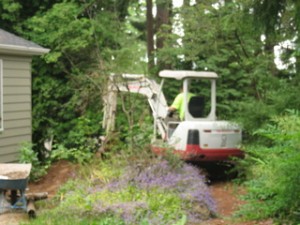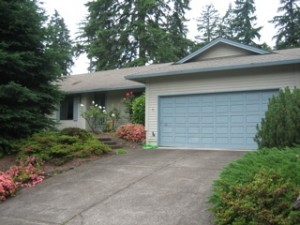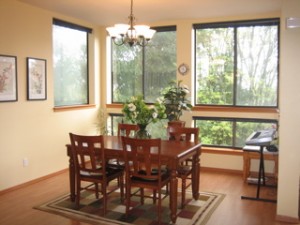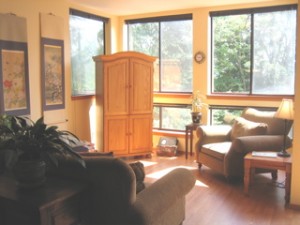Tax Credit ~ The First-Time Home-Buyers’ $8,000. Tax Credit is, of course, the talk of the town (the nation, actually). It is acknowledged that it is and has been helpful in spurring the real estate market (activity in related price ranges is steady if not occasionally feverish… especially lately!) There is much talk about extending the deadline from the current November 30th date to an as-yet-undetermined date in 2010. While it is generally agreed that the housing market is turning the corner, and a large part of this growth is related to the tax credit, there is also concern being expressed about dispersing more government money in light of recent history. So… nothing is decided as of now. There are talks about plans to:
- Extend it to all home-buyers,
- Not extend it at all,
- Increase it to $15,000.,
- Extend it and keep the terms the same,
- Offer it only to service members who have been out of the country,
- Etc.
The important thing to remember if you are a first-time home-buyer, or care about one, is that right now there is an opportunity to get an $8,000. tax credit. That means real money coming to you when you file for 2009. We do NOT know how the debate will play out regarding extending or not extending it… AND right now there is still time to take advantage of it, but you must act now.
Oil Tanks (Reminder & Update) ~ The standards for levels of contaminants are under review. In particular, ethyl benzene and naphthalene have been changed to a “carcinogenic” classification, and therefore cleanup requirements are also changing. There is now concern over the possibility of fumes potentially penetrating a home from underground & causing harm. Remember, if you have an oil tank underground on your property that has not been decommissioned, or if you are a Buyer considering a property with one: Underground oil tanks have a life of approximately 40 years. After that, they leak… and what they leak is toxic. Homeowners can be held liable for damage to soil from leaking tanks, and therefore, proper soil testing and decommissioning through a DEQ-certified environmental service is the wise choice. If you are a Seller in this situation, I would highly recommend just doing this now and getting it out of the way. It makes your home more attractive to potential Buyers, removes an objection, and protects you and the environment at the same time.
Loans ~ There are truly all kinds of loans out there right now for all kinds of Buyers. FHA loans are a current favorite, and the FHA 203 (b) is a little easier to qualify for than most conventional loans these days. There are also “Flex” loans for teachers (administrators & school nurses can also apply!), police, and firefighters. Other than the FHA loan I mentioned, you usually want a credit score of 640 or higher, and for all of them you’ll need 3 to 3.5% down. Talk to your favorite mortgage broker for more information, or give me a call and I can refer you to some great resources.
Homes on Slopes ~ Some precautions, in light of current information gained from recent slides in Portland, Lake Oswego and surrounding areas are worth noting:
- At no point should drain water be discharged onto slopes in an uncontrolled manner. Investigate energy dissipation devices to prevent erosion at discharge points.
- Make sure that any fill used on the slope is “engineer-fill”. Not all fill is able to handle the specialized drainage requirements of sloped properties.
- Make sure gutters remain clear in order to prevent over-saturation in areas not able to handle runoff.
- Keep drainage ditches or berms clear during the rainy season so that they do not direct water into areas where erosion & damage may occur.
- Keep drain inlets, outlets and weep holes at foundation, retaining walls, driveways etc clean at all times. Remove debris to prevent clogging.
- Notice any wet spots on the property. This may indicate either natural seepage, or leaking water or sewer line problems. Seek professional advice immediately.
- Regularly check irrigation systems. Drip systems are preferred on hillsides.
- Make sure roof drainage is not connected to a subsurface disposal system unless it has been approved by a geotechnical engineer.
- Keep water from accumulating next to foundations, retaining walls or basements.
- Guard against over-saturation on the hillside, as once this has occurred, damage can result very quickly and without warning.
- Seek the advice of a good Engineering firm. One source is: GeoPacific Engineering, Inc.

 The open house, a long standing tradition for marketing and selling a home, or a total waste of time? It’s actually a pretty controversial subject among Realtors. Some believe in them and others refuse to do them. I fall into the first category. I hold open a house pretty much every Sunday and some Sundays I will do a couple of open houses. I make a commitment to people who list their homes with me that I will promise one advertised open per month, at a minimum. I will do more if my time allows. This commitment keeps me pretty busy. It means that I do LOTS of open houses. And that is probably why I think that they work.
The open house, a long standing tradition for marketing and selling a home, or a total waste of time? It’s actually a pretty controversial subject among Realtors. Some believe in them and others refuse to do them. I fall into the first category. I hold open a house pretty much every Sunday and some Sundays I will do a couple of open houses. I make a commitment to people who list their homes with me that I will promise one advertised open per month, at a minimum. I will do more if my time allows. This commitment keeps me pretty busy. It means that I do LOTS of open houses. And that is probably why I think that they work. So…. you’re moving, or getting ready to sell, or in the middle of a home inspection on either end of the transaction. One of the myriad things that may cross your path is the issue of insulation. Some homes have it, some don’t. Some have it in the walls but nowhere else, some have it in the floors and ceilings. A lot depends on the era of the home and whether and how much updating has been done. If you are selling your home and your home has insulation, say underneath, that has been damaged (squirrels, etc), you may be asked to repair or replace it. If you have an older home with blown-in insulation in the attic, you may want to know what the material consists of. If you are buying a home without insulation in the walls, you may be wanting to add some after the purchase is complete. Here are some hopefully helpful tidbits on insulation:
So…. you’re moving, or getting ready to sell, or in the middle of a home inspection on either end of the transaction. One of the myriad things that may cross your path is the issue of insulation. Some homes have it, some don’t. Some have it in the walls but nowhere else, some have it in the floors and ceilings. A lot depends on the era of the home and whether and how much updating has been done. If you are selling your home and your home has insulation, say underneath, that has been damaged (squirrels, etc), you may be asked to repair or replace it. If you have an older home with blown-in insulation in the attic, you may want to know what the material consists of. If you are buying a home without insulation in the walls, you may be wanting to add some after the purchase is complete. Here are some hopefully helpful tidbits on insulation: The last 12 months have been a pretty rough time to be selling a home. Your home may have even been on the market for a period of time longer than you ever thought possible. But now you’ve gotten a good offer that you have accepted. This is a key time in any home sale. You must now get your home to pass the home inspection. I want to give you a list of 10 simple repairs you can do to prepare your home as well as a few things to do on the day of the inspection.
The last 12 months have been a pretty rough time to be selling a home. Your home may have even been on the market for a period of time longer than you ever thought possible. But now you’ve gotten a good offer that you have accepted. This is a key time in any home sale. You must now get your home to pass the home inspection. I want to give you a list of 10 simple repairs you can do to prepare your home as well as a few things to do on the day of the inspection. While today I am posting our regular list of the Lake Oswego Open Houses as advertised in the RMLS, I want to take a moment to discuss open houses in general. Open houses are probably one area in which Realtors really differ on their opinions. I have known agents who absolutely refuse to do them. One man in particular had a sign he took to listing appointments that had the words “Open House” with a big red circle and a diagonal line across the words. He was making it very clear that there was no way he would ever do an open house. I happen to have the exact opposite opinion. I happen to think that they work. Sure, you get the neighbors and the “Lookie Lou’s”, but you also get lots of great exposure to a property that needs to be sold. I think the key is to advertise the open house so that a good percentage of the people who show up are real buyers who know the price and size of the property before they get there. I hold homes open pretty much every Sunday. I believe that on average I sell at least one listing a year off of my open houses. In fact, I sold a house in Lake Oswego about 3 weeks ago as a result of my open house. So I think that open houses do have value.
While today I am posting our regular list of the Lake Oswego Open Houses as advertised in the RMLS, I want to take a moment to discuss open houses in general. Open houses are probably one area in which Realtors really differ on their opinions. I have known agents who absolutely refuse to do them. One man in particular had a sign he took to listing appointments that had the words “Open House” with a big red circle and a diagonal line across the words. He was making it very clear that there was no way he would ever do an open house. I happen to have the exact opposite opinion. I happen to think that they work. Sure, you get the neighbors and the “Lookie Lou’s”, but you also get lots of great exposure to a property that needs to be sold. I think the key is to advertise the open house so that a good percentage of the people who show up are real buyers who know the price and size of the property before they get there. I hold homes open pretty much every Sunday. I believe that on average I sell at least one listing a year off of my open houses. In fact, I sold a house in Lake Oswego about 3 weeks ago as a result of my open house. So I think that open houses do have value. This is a photo that you really never want to see, but when this sort of thing happens, it is soooooo much better to have it happen before the sale than after. This photo was taken of a home that I have currently got in escrow. The older home was recently remodeled, including a new sewer line from the house to the street. That should be enough and there’s no need for a sewer scope, right? NOT! In the course of the home inspection the buyer did have a sewer scope and a chunk of concrete was found to be blocking the line. In the course of the remodel, a stray piece of concrete had somehow found its way into the line. Who would have known without the sewer scope? And how irritating would it have been to move into a gorgeous home that was fully remodeled just to have the sewer back up immediately? This is a good lesson for one and all. Always get a sewer scope!
This is a photo that you really never want to see, but when this sort of thing happens, it is soooooo much better to have it happen before the sale than after. This photo was taken of a home that I have currently got in escrow. The older home was recently remodeled, including a new sewer line from the house to the street. That should be enough and there’s no need for a sewer scope, right? NOT! In the course of the home inspection the buyer did have a sewer scope and a chunk of concrete was found to be blocking the line. In the course of the remodel, a stray piece of concrete had somehow found its way into the line. Who would have known without the sewer scope? And how irritating would it have been to move into a gorgeous home that was fully remodeled just to have the sewer back up immediately? This is a good lesson for one and all. Always get a sewer scope! There are many reasons why a person might prefer to live in a single level home. Some are purely by choice. Things like the easy of movement while carrying laundry, or the preference for vaulted ceilings. Others are truly out of necessity due to disabilities whether they be mobility problems, advancing age, or even blindness. But for many people, living in a 1-level home is their preference.
There are many reasons why a person might prefer to live in a single level home. Some are purely by choice. Things like the easy of movement while carrying laundry, or the preference for vaulted ceilings. Others are truly out of necessity due to disabilities whether they be mobility problems, advancing age, or even blindness. But for many people, living in a 1-level home is their preference. Spring is traditionally the strongest time of year to sell your home. If you want to sell, you need to get your home ready. You want to win the beauty pageant. The place to start, before you list your home for sale, is with proper home staging. The way you live in your home and the way you sell your home are two different things. It does add a layer of care to your already busy life, but it will payoff when you sell by getting your home sold more quickly and by helping you to get the best price possible.
Spring is traditionally the strongest time of year to sell your home. If you want to sell, you need to get your home ready. You want to win the beauty pageant. The place to start, before you list your home for sale, is with proper home staging. The way you live in your home and the way you sell your home are two different things. It does add a layer of care to your already busy life, but it will payoff when you sell by getting your home sold more quickly and by helping you to get the best price possible. At the top of this article is a photo of my listing in Mt. Park. I want you to compare that photo to the one that you find to the right. Can you see the big improvement? The photo to the right is how this room used to look. This was not a home with a problem of clutter. This was a house that needed to show case the homes features. The home owner moved the living room furniture to the other end of the room in order to showcase the wonderful windows. Where a TV cabinet had blocked windows, now what you see is light and sunshine. In addition, the owner replaced several windows that had broken seals. Now when you walk in, you step back and feel the wow factor. That is what sells a house.
At the top of this article is a photo of my listing in Mt. Park. I want you to compare that photo to the one that you find to the right. Can you see the big improvement? The photo to the right is how this room used to look. This was not a home with a problem of clutter. This was a house that needed to show case the homes features. The home owner moved the living room furniture to the other end of the room in order to showcase the wonderful windows. Where a TV cabinet had blocked windows, now what you see is light and sunshine. In addition, the owner replaced several windows that had broken seals. Now when you walk in, you step back and feel the wow factor. That is what sells a house.